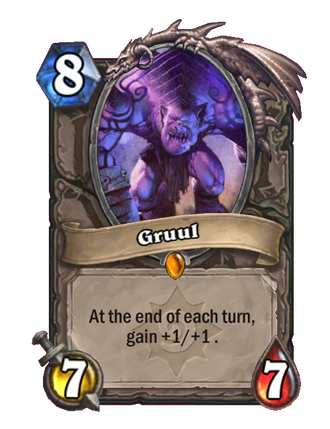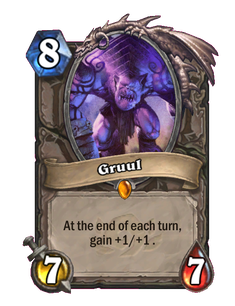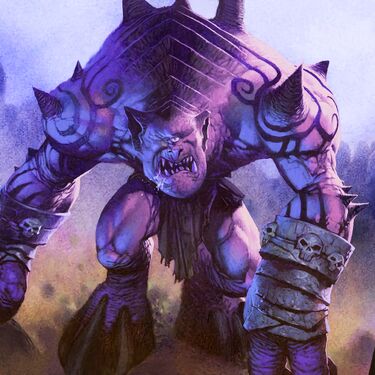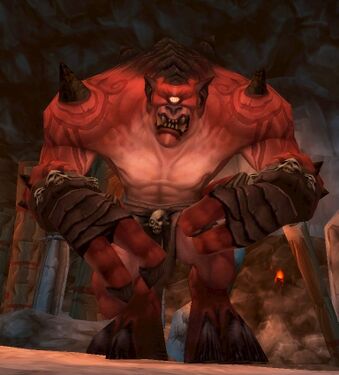Gruul
Jump to navigation
Jump to search
 This section uses content from the Warcraft Wiki.
This section uses content from the Warcraft Wiki.
This article is using {{Card template v2}}.
See the Editor's Handbook and style guide for info on how to edit this kind of article.
- You might be looking for one of these cards: Gruul (Classic), Mercenaries/Gruul, Mercenaries/Gruul (64595), Mercenaries/Gruul (64596).
Gruul is a legendary neutral minion card, from the Legacy set.
Other versions
How to get
| Type | Source | Quality | Count |
|---|---|---|---|
| Card packs | The Regular version can be opened from any of these packs: | Regular | 1 (random) |
| Card packs | The Golden version can be opened from any of these packs: | Golden | 1 (random) |
| Crafting | Craft a Regular copy for 1600 | Regular | 1 |
| Crafting | Craft a Golden copy for 3200 | Golden | 1 |
Sounds
- Play
- Attack
- ▶️
VO_NEW1_038_Attack_02.wavNo escape!
- Death
- ▶️
VO_NEW1_038_Death_03.wav<death sound>
Lore
- Gruul the Dragonkiller is the father of the seven gronn lords of the ogres, and the most powerful of them. Although he seems to be nothing but a cruel brute, he possesses intelligence. In the events unfolded in the novel Beyond the Dark Portal — shortly after
 Deathwing invaded his home — Gruul was met by the lost heroes of the Second War:
Deathwing invaded his home — Gruul was met by the lost heroes of the Second War:  Khadgar,
Khadgar,  Turalyon, and
Turalyon, and  Alleria Windrunner. They were after the
Alleria Windrunner. They were after the  Skull of Gul'dan which Deathwing possessed. After that, Gruul and his ogre minions, along with the heroes, challenged Deathwing from his perch in Blade's Edge Mountains — killing his eggs and impaling his lesser black drakes on the mountain spikes. Infuriated by this act, Deathwing landed on top of them and attacked Gruul. Although clearly no match for the mad Aspect's power, Gruul was saved by Khadgar's miraculuous spell when he disassembled some of the adamantium plates that were holding Deathwing's unstable body together resulting in Deathwing's retreat. This led to a clear devastation for the black dragonflight in Outland. The results can still be seen as impaled black dragon corpses all over Blade's Edge Mountains.
Skull of Gul'dan which Deathwing possessed. After that, Gruul and his ogre minions, along with the heroes, challenged Deathwing from his perch in Blade's Edge Mountains — killing his eggs and impaling his lesser black drakes on the mountain spikes. Infuriated by this act, Deathwing landed on top of them and attacked Gruul. Although clearly no match for the mad Aspect's power, Gruul was saved by Khadgar's miraculuous spell when he disassembled some of the adamantium plates that were holding Deathwing's unstable body together resulting in Deathwing's retreat. This led to a clear devastation for the black dragonflight in Outland. The results can still be seen as impaled black dragon corpses all over Blade's Edge Mountains.
In Warlords of Draenor
In the alternate timeline of Warlords of Draenor, Gruul was instead enslaved by ![]() Garrosh Hellscream's Iron Horde, and is used to haul fuel to the furnaces of Blackrock Foundry.
Garrosh Hellscream's Iron Horde, and is used to haul fuel to the furnaces of Blackrock Foundry.
From the Dungeon Journal:
- Garrosh knew that the surest path to breaking the gronn lay in subjugating their great father, Gruul. Known in another time as the Dragonkiller, here Gruul has been reduced to the role of menial laborer. In a cruel mockery of the Shattered Hand's warrior tradition, his hand has been replaced with a hook to enable him to more easily haul pallets of fuel to the furnace.
Trivia
- The artwork for this card comes from the World of Warcraft Trading Card Game "Crown of the Heavens" series, for the card Gronn Skullcracker.
- At the end of each turn, Gruul gains +1/+1. This mirrors a mechanic he has as a raid boss in World of Warcraft, where he gains 15% damage every 30 seconds, making him tougher to defeat as time goes on.
- The current flavor text references the classic novel Of Mice and Men by John Steinbeck, in which the character Lennie, a large half-wit, accidentally kills a puppy by petting it too roughly.
- Players who do not have Gruul in their collection are called "fuuls" by other players.
- Gruul reappears in the Trial by Felfire Challenges as the boss
 Gruul the Dragonkiller.
Gruul the Dragonkiller.
- If you play the collectible Gruul against Gruul the Dragonkiller, since the boss now has his own artwork, he will acknowledge the Gruul card having placeholder artwork by rejecting "Purple Gruul" as the real Gruul.
Gallery
Patch changes
 Patch 20.0.0.77662 (2021-03-25):
Patch 20.0.0.77662 (2021-03-25):
 Patch 1.0.0.3890 (Closed beta, 2013-10-02):
Patch 1.0.0.3890 (Closed beta, 2013-10-02):
- Flavor text now reads: "He's Gruul "the Dragonkiller". He just wanted to cuddle them… he never meant to…" (previously: "Gruul the Dragonkiller deserves his name. The bones of dragons litter his lair in the Blade's Edge Mountains.").
 Patch 1.0.0.3140 (Alpha, April or May 2013):
Patch 1.0.0.3140 (Alpha, April or May 2013):
- Added.
References
- ↑ English Voice Over Wikia - Hearthstone: Heroes of Warcraft (2014). Retrieved on 2023-12-30.








